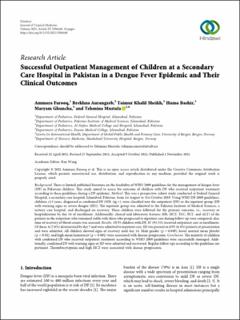| dc.description.abstract | Background. There is limited published literature on the feasibility of WHO 2009 guidelines for the management of dengue fever (DF) in Pakistani children. This study aimed to assess the outcome of children with DF who received outpatient treatment according to these guidelines during a DF epidemic. Method. This was a prospective cohort study conducted at Federal General Hospital, a secondary care hospital, Islamabad, Pakistan, from 1st August to 31st October 2019. Using WHO DF 2009 guidelines, children ≤13 years, diagnosed as confirmed DF (NS1 Ag +), were classified into the outpatient (DF) or the inpatient group (DF with warning signs or severe dengue (SD)). The inpatient group was admitted to the Pakistan Institute of Medical Sciences, a tertiary care hospital, and discharged on recovery. These children were followed for the primary outcome, i.e., recovery or hospitalization by day 14 of enrollment. Additionally, clinical and laboratory features (Hb, HCT, TLC, PLT, and ALT) of the patients in the outpatient who remained stable with those who progressed to inpatient care during follow-up were compared; also, time of recovery of blood counts was assessed. Results. Of 93 children with DF, 87 (93.5%) received outpatient care at enrollment. Of these, 6 (7.8%) deteriorated by day 7 and were admitted to inpatient care. SD was present in 6/93 (6.4%) patients at presentation and were admitted. All children showed signs of recovery until day 14. Male gender (p = 0.049), lower normal mean platelet (p = 0.02), and high mean hematocrit (p = 0.001) were associated with disease progression. Conclusion. The majority of children with confirmed DF who received outpatient treatment according to WHO 2009 guidelines were successfully managed. Additionally, confirmed DF with warning signs or SD were admitted and recovered. Regular follow-ups according to the guidelines are pertinent. Thrombocytopenia and high HCT were associated with disease progression. | en_US |

